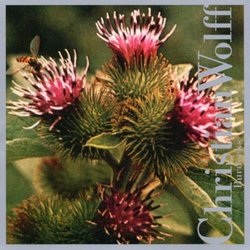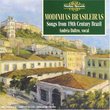| All Artists: Christian Wolff Title: Burdocks Members Wishing: 2 Total Copies: 0 Label: Tzadik Release Date: 10/23/2001 Genres: Jazz, Pop, Rock, Classical Styles: Historical Periods, Modern, 20th, & 21st Century Number of Discs: 1 SwapaCD Credits: 1 UPC: 702397707127 |
Search - Christian Wolff :: Burdocks
 | Christian Wolff Burdocks Genres: Jazz, Pop, Rock, Classical
|
Larger Image |
CD DetailsSimilar CDs |
CD ReviewsDon't start here 06/18/2004 (4 out of 5 stars) "this cd is pretty good, but not really a great demonstration of what wolff's about; nor is it the best recording of burdocks. my main gripe is that, at least burdocks, sounds far too much like the music usually played by the players assembled here, and not enough like wolff. fred frith is great, but i think he's better at playing fred frith (he might disagree). sonic youth's burdocks recording is better and also features the composer. if you want a good introduction to wolff's music, get one of the recordings by the barton workshop; once you've got some of those, then get this. so... this cd is good and you should get it if you're a wolff-nut like me, but it isn't an appropriate introduction." Gentle,unassuming, threadbare lyrical as well scarecrow | Chicago, Illinois United States | 11/09/2001 (5 out of 5 stars) "Wolff when a teenager hung out with John Cage in New York City, later Morton Feldman and Earle Brown, all affectiontly referred to now,half a century later as "The Cage School". Europeans as well made this foursome a focus for contemplation and a means for promuligating their various growing repertoire of works in the Fifties.
Later Morton Feldman became very well respected amongst the British cadre of creativity, as Cardew,Skempton, the AMM aesthetic(Rowe's utilzation of the radio as a musical instrument as well owes some debt to this school). This as well as the Satie influence( A Cage icon) in London is overwhelming. Feldman was always the lyrical innovative denizen of pure beauty,not afraid of subjectivity whereas Cage the tireless organizer demi-god of purposeless purpose,refused that world after the Fifties. Brown was more the doctrinaire indeterminacist,somewhere in between Cage and Feldman conceptually,finely honing creative pathways(notational, proportional means) Cage's mastodonic edifice surely implied. And Wolff as well brought his own signature to this school, writing works that were structured looking straight down the page as opposed to linearly, moment to moment. "For 1,2 or 3" is an early masterpiece, with fascinating graphics notational means,very gentle,unassuming in inflections. Then with the advent of the Vietnam War, the "times a changin" Wolff adopted a democratic socialism following in a safer distanced perspective than the more anarchist Left Frederic Rzewski (in Rome), or the Maoist extremism of Cornelius Cardew in London. In retrospect Wolff's sober choice of this path has certainly bore wonderful fruit for his prolific creativity.Even with respect to his early apolitical works, which although gentle, and beautiful, were coldly wrought, and arbitrary; Like a tail-ending of the Cage gesturing.His political works with genuine reference now to a committed body of the political lifeworld,is indeed interesting, thorny,unfinished,textural,yet retains a high degree of the abstract,like Charles Ives. "Burdocks" was the last of these purely focused indeterminate graphic works,although written between 1970 and 1971, without utilization of political reference. And it is Wolff's most widely played work, well, in Europe, Germany especially. It hovers around the discreet world of pure Zen-like moments, drifting one after another in succession, no creation of a finely nuanced goal oriented object, although that is the result here in many moments. Tzadik CD label outta New York assembled some heavy hitters here with Fred Frith,Gordon Mumma,on horn(recall this Sonic Arts Union of Ann Arbor,also a post=Cage manifestation), and Wolff himself on melodica,piano.The result is intended-ly mixed and beautiful,and boring at times. The "1992 TUBA SONG" is wonderfully disarming,like a piece for the oppressed, neglected dispossessed cadre of Tuba,it is finely, gently again wrought, unassuming like Wolff's other political music. With occasional low pedal tones,blats, flabbing down in the forbidden depths. Tubist Peter Wahrhaftig it seemed felt ashamed to simply play the childlike simple melodic lines Wolff provides, he always seemed timid in simply being musical. Some of the motives could have been a little faster to propell the line forward I thought. Wolff allows these performative freedoms, which are indeed dangerous if not strictly thought through. Ursula Oppens, and Sally Pinkus are two commanding Wolff interpreters, listen to their performances of Wolff's piano music. The "Trio III" is more the same, threadbare moments, focused, non sequiter, gentle, various silences interrupted with seemingly personal subjectivity here.Wolff also utilizes a rhythmic device, where each player kinda dovetailed into each other,that is quite attrative.Something I've heard in his "Peace March" for flutes. Wolff can be poetic, unintentionally or from some opaque distance, as his piano "preludes". His music however remains "dangerous" and "treacherous" to perform convincingly. And what is convincingly mean?, interesting, communicative,mind engaging. We've lived long enough now with this music that we can distinguish good from bad. I know that's rather un=Zen like but still useful." |

 Track Listings (3) - Disc #1
Track Listings (3) - Disc #1

